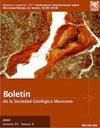Comment to "Porphyry-related high-sulfidation mineralization early in Central American Arc Development: Cerro Quema deposit, Azuero Peninsula, Panama" by Perelló et al., (2020)
IF 0.4
4区 地球科学
Q4 GEOLOGY
引用次数: 1
Abstract
The Cerro Quema Au-Cu deposit is hosted by a dacite dome complex of the Río Quema Formation, a Late Campanian-Maastrichtian volcano-sedimentary sequence of the Panamanian magmatic arc. Its formational age is constrained at ~49 Ma by field evidences, crosscutting relationships and 40Ar/39Ar geochronology (Corral et al., 2016, Corral, 2021). The recent molybdenite Re-Os dates by Perelló et al. (2020) claim that ore is spatially and temporally related to the host volcanic domes at ~71 Ma. After a thorough review of the geologic, geochemical and geochronological data from the Cerro Quema area, it is concluded that the Re-Os dates of Perelló et al. (2020) are not representative of the Cerro Quema formational age. Their proposed formational age at ~71 Ma is significantly older than the age of the host rock (~67 Ma). Furthermore, they invoke a previously unrecognized regional-scale magmatic event solely based on their molybdenite Re-Os dates. Instead, the Cerro Quema genetic model discussed here, in which magmatic-hydrothermal fluids derived from porphyry copper-like intrusions associated with the Valle Rico batholith produced the Au-Cu mineralization at ~49 Ma, is consistent with the geology, geochemistry and geochronology of the Azuero Peninsula.Perelló等人对“中美洲弧发育早期与斑岩相关的高硫化矿化:巴拿马阿祖罗半岛Cerro Quema矿床”的评论,(2020)
Cerro Quema Au Cu矿床由Río Quema组的英安岩圆顶杂岩托管,该组是巴拿马岩浆弧的晚Campanian Maastrichtian火山沉积序列。其形成年龄受现场证据、横切关系和40Ar/39Ar地质年代限制在~49 Ma(Corral et al.,2016,Corral,2021)。Perelló等人最近的辉钼矿Re-Os日期。(2020)声称,矿石在空间和时间上与约71 Ma的主火山穹丘有关。在彻底审查了Cerro-Qema地区的地质、地球化学和地质年代数据后,得出结论,Pereló等人的Re-Os日期(2020)不能代表Cerro-Qima地层时代。它们提出的~71 Ma的形成年龄明显大于主岩的年龄(~67 Ma)。此外,他们仅根据辉钼矿Re-Os日期,就援引了以前未被识别的区域规模岩浆事件。相反,这里讨论的Cerro-Qema成因模型与阿祖罗半岛的地质、地球化学和地质年代一致,其中源自与Valle Rico岩基相关的斑岩类铜侵入体的岩浆热液在~49 Ma产生了Au-Cu矿化。
本文章由计算机程序翻译,如有差异,请以英文原文为准。
求助全文
约1分钟内获得全文
求助全文
来源期刊
CiteScore
1.40
自引率
12.50%
发文量
34
审稿时长
50 weeks
期刊介绍:
The Boletín de la Sociedad Geológica Mexicana is a completely free-access electronic journal published semi-annually that publishes papers and technical notes with its main objective to contribute to an understanding of the geology of Mexico, of its neighbor areas, and of geologically similar areas anywhere on Earth’s crust. Geology has no boundaries so we may publish papers on any area of knowledge that is interesting to our readers.
We also favor the publication of papers on relatively unfamiliar subjects and objectives in mainstream journals, e.g., papers devoted to new methodologies or their improvement, and areas of knowledge that in the past had relatively little attention paid them in Mexican journals, such as urban geology, water management, environmental geology, and ore deposits, among others. Mexico is a land of volcanos, earthquakes, vast resources in minerals and petroleum, and a shortage of water. Consequently, these topics should certainly be of major interest to our readers, our Society, and society in general. Furthermore, the Boletín has been published since 1904; that makes it one of the oldest scientific journals currently active in Mexico and, most notably, its entire contents, from the first issue on, are available online.

 求助内容:
求助内容: 应助结果提醒方式:
应助结果提醒方式:


